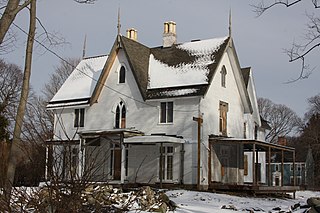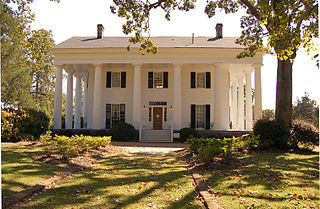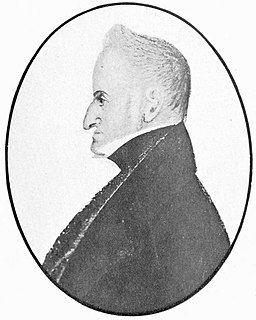
A privateer is a private person or ship that engages in maritime warfare under a commission of war. Since robbery under arms was a common aspect of seaborne trade, until the early 19th century all merchant ships carried arms. A sovereign or delegated authority issued commissions, also referred to as a letter of marque, during wartime. The commission empowered the holder to carry on all forms of hostility permissible at sea by the usages of war. This included attacking foreign vessels and taking them as prizes, and taking prize crews as prisoners for exchange. Captured ships were subject to condemnation and sale under prize law, with the proceeds divided by percentage between the privateer's sponsors, shipowners, captains and crew. A percentage share usually went to the issuer of the commission.

Bristol is a town in Bristol County, Rhode Island, US as well as the historic county seat. The town is built on the traditional territories of the Pokanoket Wampanoag. It is a deep-water seaport named after Bristol, England.

Edward Colston was an English merchant, philanthropist and Tory Member of Parliament who was involved in the Atlantic slave trade.

Cephas Thompson was a successful, largely self-taught, early nineteenth-century itinerant portrait painter in the United States. He was born, died, and lived most of his life in Middleborough, Massachusetts, but traveled extensively down the Atlantic coast and lived far from home for months at a time while pursuing his career as a portraitist.

The history of Liverpool can be traced back to 1190 when the place was known as 'Liuerpul', possibly meaning a pool or creek with muddy water, though other origins of the name have been suggested. The borough was founded by royal charter in 1207 by King John, made up of only seven streets in the shape of the letter 'H'. Liverpool remained a small settlement until its trade with Ireland and coastal parts of England and Wales was overtaken by trade with Africa and the West Indies, which included the slave trade. The world's first commercial wet dock was opened in 1715 and Liverpool's expansion to become a major city continued over the next two centuries.

James DeWolf was a slave trader, a privateer during the War of 1812, and a state and national politician. He served as a state legislator for a total of nearly 25 years, and in the 1820s as a United States senator from Rhode Island for much of a term. Along with the slave trade, DeWolf invested in sugar and coffee plantations in Cuba and became the wealthiest man in his state. By the end of his life, he was said to be the second-richest person in the entire United States. During his lifetime, his name was usually written "James D'Wolf".

Samuel Pomeroy Colt was an industrialist and politician from Rhode Island. He formed the United States Rubber Company, later called Uniroyal and the largest rubber company in the nation.

Russell Warren (1783–1860) was an American architect, best known for his work in the Greek Revival style. He practiced in Bristol and Providence.

Bristol, a port city in south-west England, was involved in the transatlantic slave trade. Bristol's part in the trade was prominent in the 17th and 18th centuries as the city's merchants used their position to gain involvement. It is estimated that over 500,000 enslaved African people were traded by Bristol merchants.
Traces of the Trade: A Story from the Deep North is a 2008 documentary film directed by Katrina Browne, Alla Kovgan, and Jude Ray.

Juniper Hill Cemetery is a historic cemetery at 24 Sherry Avenue in Bristol, Rhode Island founded by George R.Usher, James D'Wolf Perry, Byron Diman, Ambrose E. Burnside, James H. West, Charles H. R. Doringle, and Lemanuel W. Briggs. The original 22 acres (89,000 m2) were purchased from the descendants of Levi DeWolf, a local farmer and slave hauler, in 1855, and the cemetery corporation that owns it was chartered in January 1856. It is a fine example of the mid-19th century rural cemetery movement, with winding lanes and paths. The landscape was designed by Niles Bierragaard Schubarth, who had done similar work at other Rhode Island cemeteries. Its main entry is a massive stone gate built in 1876, and there is a gate house just inside, designed by Clifton A. Hall and constructed from granite quarried on site.

Longfield is an historic house at 1200 Hope Street in Bristol, Rhode Island.

The Chestnut Street District is a historic district bounded roughly by Bridge, Lynn, Beckford, and River Streets in Salem, Massachusetts. It was added to the National Register of Historic Places in 1973 and enlarged slightly in 1978. The district contains a number of architecturally significant works of Samuel McIntire, a builder and woodworker who had a house and workshop at 31 Summer Street, and who designed and built a number of these houses, and others that display the profits made in the Old China Trade by Salem's merchants. The district is a subset of a larger locally designated McIntire Historic District.

Antebellum architecture is the neoclassical architectural style characteristic of the 19th-century Southern United States, especially the Deep South, from after the birth of the United States with the American Revolution, to the start of the American Civil War. Antebellum architecture is especially characterized by Georgian, Neo-classical, and Greek Revival style homes and mansions. These plantation houses were built in the southern American states during roughly the thirty years before the American Civil War; approximately between the 1830s to 1860s.

Musée Patamécanique is a private museum located in the Historical District of Bristol, Rhode Island. Founded in 2006 by Neil Barden Salley, it is open by appointment only to friends, colleagues, and occasionally to outside observers. The museum is presented as a hybrid between an automaton theater and a cabinet of curiosities and contains works representing the field of Patamechanics, an artistic practice and area of study chiefly inspired by Pataphysics.
Thomas King was a British merchant and privateer who acquired wealth through trade and privateering.
Michael Becher was a Bristol-born English slave trader and merchant. Becher was from an established Bristol commercial family, and he took over his father's slave trading firm

Mark Anthony DeWolf was an American merchant and slave trader.

The DeWolf family is a prominent Canadian and American family that traces its roots to Balthazar DeWolf.
Liverpool, a port city in north-west England, was involved in the transatlantic slave trade. The trade developed in the eighteenth century, as Liverpool slave traders were able to supply fabric from Manchester to the Caribbean islands at very competitive prices.


















